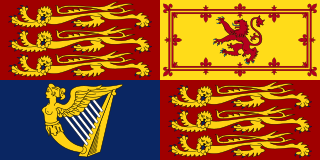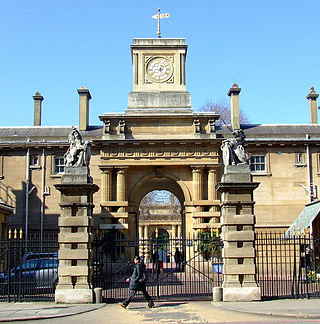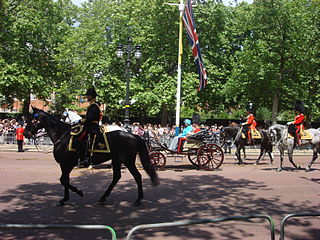
The monarchy of the United Kingdom, commonly referred to as the British monarchy, is the form of government used by the United Kingdom by which a hereditary monarch reigns as the head of state, with their powers regulated by the British Constitution. The term may also refer to the role of the royal family within the UK's broader political structure. The monarch since 8 September 2022 is King Charles III, who ascended the throne on the death of Queen Elizabeth II, his mother.
A civil list is a list of individuals to whom money is paid by the government, typically for service to the state or as honorary pensions. It is a term especially associated with the United Kingdom, and its former colonies and dominions. It was originally defined as expenses supporting the British monarchy.

The royal standard of the United Kingdom is the banner of arms of the monarch of the United Kingdom, currently Charles III. It consists of the monarch's coat of arms in flag form, and is made up of four quarters containing the arms of the former kingdoms of England, Ireland, and Scotland. There are two versions of the banner, one used in Scotland in which the Scottish quarters take precedence, and one used elsewhere in which the English quarters take precedence.

The Royal Mews is a mews, or collection of equestrian stables, of the British royal family. In London these stables and stable-hands' quarters have occupied two main sites in turn, being located at first on the north side of Charing Cross, and then within the grounds of Buckingham Palace.
Master of the Horse is an official position in several European nations. It was more common when most countries in Europe were monarchies, and is of varying prominence today.
An equerry is an officer of honour. Historically, it was a senior attendant with responsibilities for the horses of a person of rank. In contemporary use, it is a personal attendant, usually upon a sovereign, a member of a royal family, or a national representative. The role is equivalent to an aide-de-camp, but the term is now prevalent only among some members of the Commonwealth of Nations.
A royal household or imperial household is the residence and administrative headquarters in ancient and post-classical monarchies, and papal household for popes, and formed the basis for the general government of the country as well as providing for the needs of the sovereign and their relations. It was the core of the royal court, though this included many courtiers who were not directly employed by the monarch as part of the household.

The Crown Equerry is the operational head of the Royal Mews of the Royal Household of the Sovereign of the United Kingdom. As executive head of the Royal Mews Department, he is responsible for the provision of vehicular transport for the sovereign, both cars and horse-drawn carriages. Train travel is arranged by the Royal Travel Office, which also co-ordinates air transport.
Colonel Sir Dermot McMorrough Kavanagh, grandson of Arthur MacMurrough Kavanagh, was an Irish-born Crown Equerry of the Royal Household of the Sovereign of the United Kingdom from 1941 to 1955. He was educated at Eton College, and served in the 11th Hussars from 1909.
Colonel Sir Arthur Edward Erskine was a British soldier and courtier. He was Crown Equerry in the Royal Household of the Sovereign of the United Kingdom from 1924 to 1941.
Major John Richard Groves was the first Crown Equerry in the Royal Household, appointed in 1854.
Lieutenant-Colonel Sir Walter Hugh Malcolm Ross, was a member of the Royal Household of the Sovereign of the United Kingdom, and from 2006 to 2008, master of the household to then Prince Charles.

In modern heraldry, a royal cypher is a monogram or monogram-like device of a country's reigning sovereign, typically consisting of the initials of the monarch's name and title, sometimes interwoven and often surmounted by a crown. Such a cypher as used by an emperor or empress is called an imperial cypher. In the system used by various Commonwealth realms, the title is abbreviated as 'R' for 'rex' or 'regina'. Previously, 'I' stood for 'imperator' or 'imperatrix' of the Indian Empire.
The Grand Écuyer de France or Grand Squire of France or Grand Equerry of France was one of the Great Officers of the Crown of France and a member of the Maison du Roi during the Ancien Régime. The name "écuyer", the French word for squire, is the origin for the French word "écurie" (stable) and the English word equerry. The position was roughly equivalent to the United Kingdom positions of Master of the Horse and the Crown Equerry.

Windsor Grey is a moniker for the grey horses used by the British monarchy to pull carriages and state coaches in ceremonial processions such as those for coronations, royal weddings, Trooping the Colour, and the opening of Parliament. They are named for Windsor Castle where they were originally stabled, though today they live at the Royal Mews near Buckingham Palace.
The Royal Households of the United Kingdom are the collective departments that support members of the British royal family. Many members of the royal family who undertake public duties have separate households. They vary considerably in size, from the large household that supports the sovereign to the household of the Prince and Princess of Wales, with fewer members.
The list of Diamond Jubilee Honours 2012 was released on 13 September 2012 and made appointments and promotions within the Royal Victorian Order to recognise contributions to the celebration of the Diamond Jubilee of Elizabeth II in 2012. The Royal Victorian Order is a dynastic order of knighthood recognising distinguished personal service to the Sovereign, and remains in the personal gift of the monarch.

The funeral directors to the Royal Household of the Sovereign of the United Kingdom are selected and appointed by the Lord Chamberlain's Office.

Lieutenant Colonel Sir John Mansel Miller, was a British Army officer and equestrian who served as Crown Equerry to Queen Elizabeth II from 1961 to 1987.

The state and royal cars of the United Kingdom are kept at the Royal Mews, Buckingham Palace, where a wide range of state road vehicles are kept and maintained. The vehicles also are stored at other royal residences as required.








